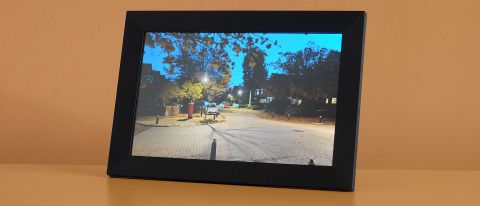TechRadar Verdict
The Portrait 01 is a good value photo frame that doesn’t rely on cloud storage or a paid subscription. It offers decent picture quality and lets you transfer photos over the internet or via USB/SD memory card. If you're after a no-nonsense option that doesn't break the bank, it's well worth a look.
Pros
- +
Good value
- +
Multiple options for photo transfers
- +
Decent picture quality
Cons
- -
Prosaic build
- -
Doesn't seem to support SDXC cards
- -
Software not as slick as the best
Why you can trust TechRadar
Two-minute review
The Aeezo Portrait 01 is a relatively cheap and cheerful digital photo frame. But despite its price tag, it's actually a good deal more flexible than many of the bigger names we've tested. If you're after a no-nonsense, good value frame, it's one of the best digital photo frames around.
You can add photos using the Frameo app and add 'friends', which lets other folks add pictures, wherever they are. If you want to keep things simple, you can also insert an SD card or attach a USB hard drive/stick. The Aeezo Portrait 01 will either move them over to its 16GB of internal storage or play them directly off the external storage.
This means that you aren't reliant on an external service. The Aeezo Portrait 01 won’t become useless if your Wi-Fi does down, or if the company that runs Frameo stops existing altogether.

We are also largely happy with the Aeezo Portrait 1’s reproduction of photos. They don’t look overly sharp or soft, and while color depth is not sensational, we found fewer nits to pick here than in some pricier frames.
Pay attention and you can tell where the money was saved, though. The Aeezo Portrait 01’s interface is clearly based on Android, so you don't get truly bespoke, elegant software here. Does it work well? Sure, it works just fine.
The app is less glossy than some of the others we’ve tried. Frameo tries to inject some of the 'social network lite' angle that many modern photo frames aim for, but its presentation could be better and it feels a little thin. The Aeezo Portrait 01’s stand is also almost comically basic. But like so many other aspects here, it still works as it should.
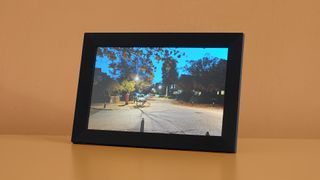
If we were reviewing the Aeezo Portrait 01 from an interior design perspective, it might fare worse. But we’re here for the tech and user experience, and it does fairly well in both areas and simply seems a good deal compared to its rivals.
The Aeezo Portrait 01 comes in two sizes, 9in ($104 / £99) and 10in (currently $99 / £109). We tested the smaller version. You will also find very similar-looking frames from different brands online. We expect they are quite comparable – this is as close to a generic Chinese photo frame as we’ve tested — but we can’t vouch for their quality.
Aeezo Portrait 01: Design
This is quite a simple and unobtrusive photo frame. Most of the frames we test have bigger surrounds, to further separate their appearance from that of a smart speaker, and because built-up frames can often seem that bit classier. Call it 'no-frills' if you like.
However, the Aeezo Portrait 01 still has enough going on to ensure it doesn't look like a propped-up tablet. There’s contouring to the black plastic surround and the corners are relatively sharp-edged, which is not a common style in consumer tech.
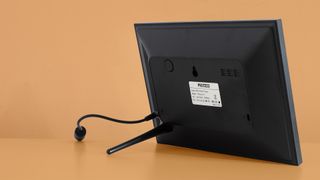
This is an all-plastic affair, though, including the screen covering. It’s the most common construction style for digital photo frames in our experience, even in significantly more expensive models.
The Aeezo Portrait 01’s stand sits in one place on the back, but it’s angled to let the frame sit either in portrait or landscape. It looks just like a router aerial – hardly classy – and screws into the rear. However, our only real worry is that it leaves the frame with below-average stability, letting it fall backward quite easily. If you have a cat or a younger child, keep it in mind. There’s also a wall mount point on the back.
The Aeezo Portrait 01’s screen measures nine inches across and has a resolution of 1280 x 800 pixels. This is the same resolution as you see in budget 10-inch tablets, giving this one slightly higher pixel density.
The photos look good, too. While the deepest tones won’t look as poppy as they would do on, say, an OLED screen phone, colors do appear lifelike. And given you’re almost certainly always going to be putting photos of a higher resolution than the frame itself, we’re happy with how they are handled.
Hard edges aren’t too sharpened or too softened in an attempt to hide the low panel resolution. Of the affordable frames we’ve tested recently, only the Aura Carver strikes a better balance.
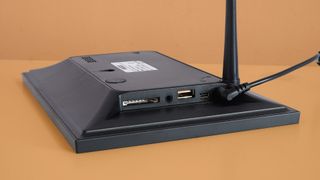
The Aeezo Portrait 01's maximum brightness isn't that impressive, though. At 227 nits, it's around 10% less bright than the category average, while the Aura Carver is almost twice as bright.
Whether it matters revolves around where you will put the Aeezo Portrait 01. It has no chance of competing with direct sunlight from a nearby window, but will cope fine in most rooms. Here’s how much power it consumes, according to our power meter:
| Mode | Power consumption | Row 0 - Cell 2 |
| 100% brightness | 4W (0.096kWh per 24 hours) | Row 1 - Cell 2 |
| 50% brightness | 3W (0.072kWhr per 24 hours) | Row 2 - Cell 2 |
| Standby | 1W (0.024kWhr per 24 hours) | Row 3 - Cell 2 |
Aeezo Portrait 01: usability
The Aeezo Portrait 01 is a surprisingly versatile photo frame. You can use it as a purely internet connected frame, flinging over photos from your phone at a whim. Or you can invite your friends to do the same.
Friends will just need to insert a code in the Frameo companion app (these are one-use and time-limited to avoid codes being passed around). The app is available from the Apple App Store and Google Play for Android phones and tablets.
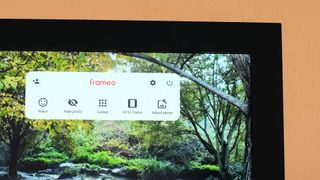
Alternatively, you can choose to ignore the connected side altogether and use an SD card or USB hard drive. You can take this to extremes if you like. We played a full movie off the Aeezo Portrait 01, loaded onto a USB stick. There’s even sound, as the frame has a basic built-in speaker on the back.
The way we’d probably use external storage is to pull images over from an SD card onto the internal memory. There’s 16GB, although you only have access to 11.2GB of it for photos. That is enough for thousands of JPEG photos.
This kind of flexibility is great, but we couldn’t get the frame to recognize SDXC memory cards, only standard SD ones. Memory cards from 32GB to 2TB typically use this SDXC format, so it could be a big issue for photographers.

The Aeezo Portrait 01 has a responsive, but not exactly sophisticated-looking, interface. Tap the screen and a pop up lets you hide a photo from the gallery, see the whole library and alter how the image is presented – rotating and cropping. There’s also a 'react' button, which lets you select an emoji. Friends and family who send you images using the Frameo app will be able to see this reaction in their own app.
There’s also a deeper settings menu on the frame, which looks exactly like that of an Android tablet, just with slightly different contents. Here you choose how long photos are displayed, how bright you want the frame to be (its brightness does not change to suit the room automatically) and when you want to schedule the frame to sleep and wake up each day.
Unlike some pricier models, there’s no 'auto sleep' feature here, so you should set times or turn the thing off regularly using the power button on the back.
Much as we saw when talking about the Aeezo Portrait 01’s design, this frame is unlikely to impress if you expect thick layers of gloss. However, we’ve tested more expensive frames that are much less responsive to navigate.
Should I buy the Aeezo Portrait 01?

Buy it if..
You’re after a good deal
We think the Aeezo Portrait 01 represents good value among photo frames. It cuts off some of the software gloss, and the design is pretty generic, but it can ultimately do the job of display photos just as well as pricier models – better in some cases.
You want online and offline use
The Aeezo Portrait 01 can be used with the Frameo app, letting you (and friends) send photos to it whenever you are. Or you can plug in an SD card or USB drive to either display photos or videos directly from them or bring them over to the internal storage. There’s no paid subscription involved here, as there is in some photo frames.
You’re after a smaller frame
Our test frame is Aeezo’s 9-inch model, where many have 10-inch screens. Aeezo’s design also has a less built-up frame surround than many. This means it isn't as large a presence on your surfaces as some frames, so maybe ideal if you don’t have masses of space to fill in the first place.
Don't buy if...
You demand glossy sophistication
We think of the Aeezo Portrait 01 as a no-nonsense, decent-value photo frame. Both the Frameo app and the on-screen interface lack a little sophistication, the latter because there’s quite a lot of interface there to dive into. For a more pared-back experience, get an Aura photo frame instead.
You need SDXC card support
This photo frame supports SD cards but we could only get it to recognize SD and SDHC cards, of sizes up to 32GB. Higher capacities may not work.
You need a super-bright frame
With a maximum brightness of 227 nits, the Aeezo Portrait 1 does not have the display power to compete with loads of ambient light. We still think it’s bright enough for most homes and rooms, but pricier models we’ve tried get 10% to 100% brighter.
Andrew is a freelance journalist and has been writing and editing for some of the UK's top tech and lifestyle publications including TrustedReviews, Stuff, T3, TechRadar, Lifehacker and others.
